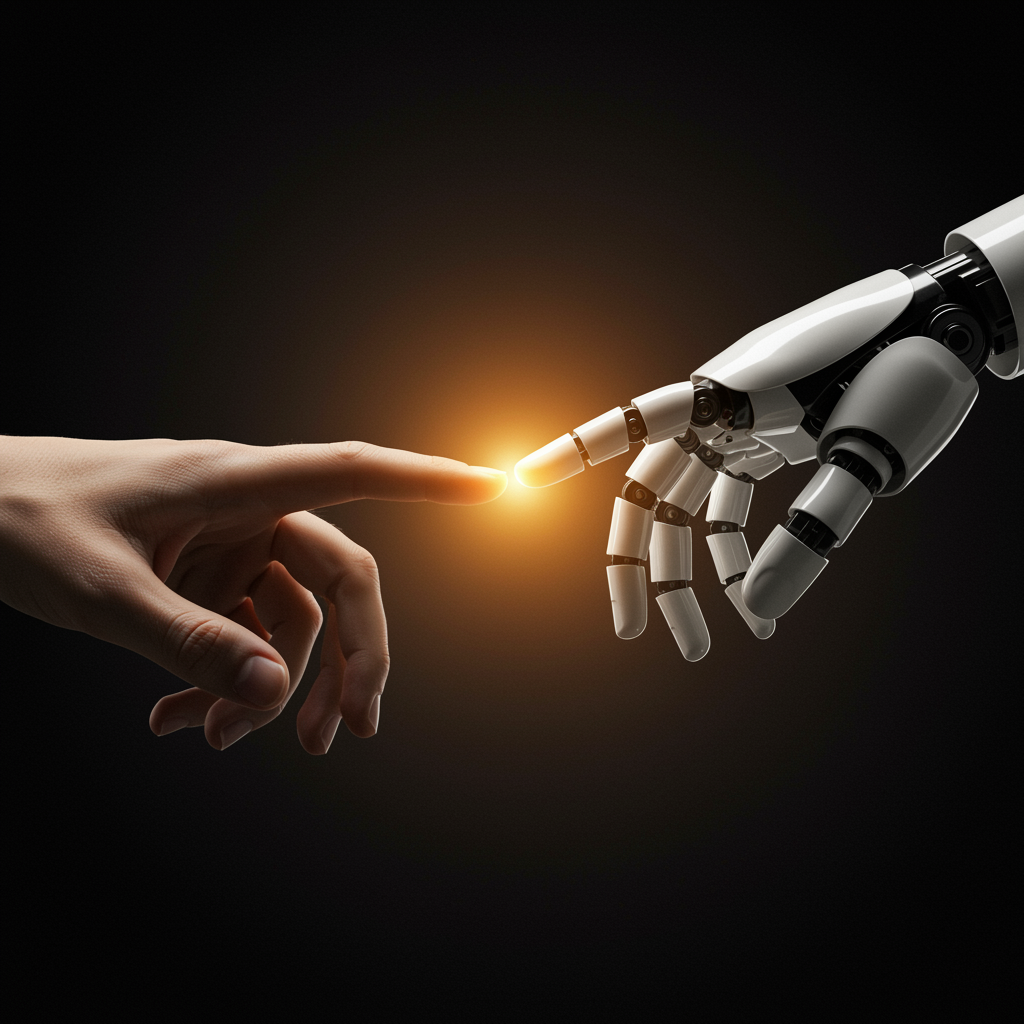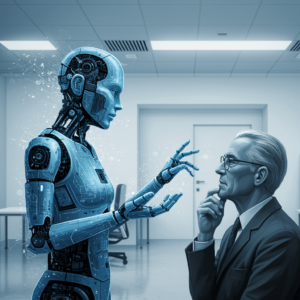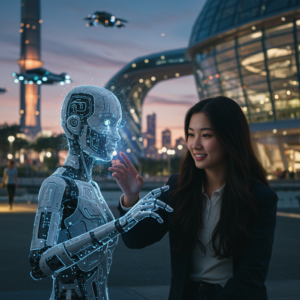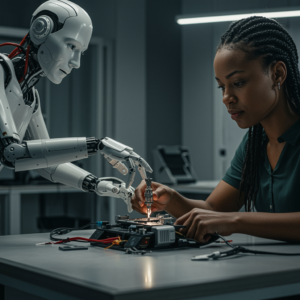
Human and AI
Co-Creating the Future: AI and Human Working Together
Introduction: A New Kind of Partnership
It feels like we’re standing on the edge of something big, doesn’t it? The relationship between AI and human minds is changing fast. We’re moving past the idea of AI as just a clever tool. Instead, we’re entering an era of what experts call collaborative intelligence. Think of it as a true partnership, where the unique smarts of artificial intelligence human capabilities blend with our own innate talents. Together, we can achieve things neither could manage alone [5]. The conversation is shifting – it’s less about AI *versus* humans, and more about AI and humans working hand-in-hand to co-create, innovate, and reshape our world [4, 24]. This isn’t just about getting things done faster; it’s about unlocking the potential to tackle huge global challenges and spark incredible creativity [16, 35].
Defining the Partnership: More Than Just Assistance
This idea of AI and human collaboration marks a real turning point. We’re starting to see AI not just as a helpful assistant, but as a thinking partner [2, 4, 24]. Co-creation means humans and AI systems actively pooling their strengths – generating fresh ideas, untangling complex problems, and producing creative work together [25, 27, 30]. This “hybrid intelligence” approach [1, 5, 43] is all about blending our human intuition, ethical compass, and real-world understanding with AI’s incredible speed, analytical power, and knack for finding patterns [2, 4, 7, 34]. The aim? A powerful thinking partnership where the AI to human exchange sparks innovations we couldn’t have dreamed of before.

The Power Couple: Playing to Strengths
Why does this collaboration work so well? Because we each bring something unique and valuable to the table:
- Human Strengths: We humans bring that irreplaceable spark of creativity, gut feeling (intuition), and the vital ability to connect with others (empathy) [2, 4, 6, 56]. Our power lies in thinking critically, understanding the subtleties of context, navigating grey areas, making ethical calls, and reading the room – skills learned through life and complex social interactions [4, 80, 93]. We’re good at thinking outside the box and rolling with the punches.
- AI Strengths: Artificial intelligence, on the other hand, offers mind-boggling speed for crunching massive amounts of data, spotting patterns we might miss, performing repetitive tasks flawlessly, and achieving incredible precision [2, 4, 11, 34, 55]. Today’s AI can pull together information from different fields, organize complex data, and quickly build upon human ideas, acting like a super-powered analysis and optimization partner [4].
This dynamic duo allows AI to handle the heavy lifting – the data-heavy, repetitive, or highly structured tasks. That frees us humans up to focus on the bigger picture: strategic thinking, creative breakthroughs, ethical guidance, complex problem-solving, and those crucial person-to-person interactions that AI just can’t replicate [2, 11, 31, 80, 93].
Real-World Teamwork: AI and Humans in Action
This isn’t just theory; the transformative power of AI and human partnerships is already making waves everywhere:
- Healthcare: Imagine AI helping doctors spot potential issues in scans or suggesting personalized treatment options based on vast data [2, 11, 42, 45]. The human touch remains vital – doctors confirm findings, explain things to patients, and provide compassionate care, ensuring technology serves people [58].
- Finance: AI acts like a tireless analyst, spotting risks or market trends in mountains of data, giving human experts crucial insights [2, 11]. Meanwhile, AI chatbots can handle simple queries, freeing up human advisors to tackle complex financial planning that requires trust and deep understanding.
- Manufacturing: AI systems can predict when a machine might fail, alerting technicians *before* it breaks down, saving time and money [11]. AI also helps with quality checks, while humans step in to handle tricky or critical issues.
- Creative Fields: Tools like ChatGPT or Midjourney are becoming creative partners, helping artists, writers, and designers brainstorm, break through blocks, and explore new styles [6, 10, 12, 28, 30, 56]. The AI to human idea flow can be incredibly stimulating, but it still needs human taste, refinement, and context to truly shine [57].
- Research and Writing: Researchers can use AI to quickly digest huge amounts of information or structure their findings [4, 9, 54]. Writers might use it to polish arguments or just get past that dreaded blank page, treating AI like a very organized thinking buddy [57].

What’s In It For Us? The Benefits of Teaming Up
So, what does this synergy between AI and humans actually deliver? The advantages are becoming clear:
- Getting More Done, Faster: By automating tedious tasks and speeding up things like data analysis, we see real boosts in productivity [10, 14, 51, 55]. Some studies show AI can generate ideas much more efficiently than humans alone [10, 57].
- Sparking Creativity and New Ideas: AI can be a fantastic source of inspiration, offering diverse options and helping us overcome creative ruts [2, 6, 10, 12, 57]. Research suggests AI help can lead to more novel outputs and a greater volume of ideas [10, 57].
- Making Smarter Choices: With AI handling the heavy data lifting, humans can make more informed, evidence-backed decisions [2, 7].
- Leveling the Playing Field: AI tools can help newcomers or those less experienced perform tasks closer to an expert level, offering guidance and automating tricky steps [10, 57]. We’re seeing this happen in fields like sales and writing [57].
- Better Results (Often): While it’s not a magic bullet, AI and human teams frequently achieve better results than humans alone, especially when AI tackles the data and humans guide the strategy [7, 10, 32, 39, 57, 92]. For example, salespeople using AI support closed significantly more deals [57].
Navigating the Bumps: Challenges We Face
Of course, building these effective AI and human partnerships isn’t always smooth sailing. There are real hurdles to overcome:
- Can We Trust the Output? (Reliability): AI, especially the creative kind, can sometimes get things wrong, make stuff up (“hallucinate”), or reflect biases [6, 9, 11, 30, 56]. This means humans absolutely need to stay vigilant, double-check facts, and use critical thinking, because AI doesn’t truly ‘understand’ like we do [67, 76].
- Understanding the ‘Why’ (Trust & Transparency): Often, AI works like a “black box” – we see the answer, but not how it got there. This lack of clarity can make it hard to trust the AI’s suggestions [2, 59, 77]. Worries about hidden biases or inconsistent results can make people hesitant, especially when the stakes are high [78].
- Doing the Right Thing (Ethics): Big questions loom around data privacy, fairness (is the AI biased?), who’s responsible when things go wrong, and the impact on jobs [2, 59, 63, 70, 72, 78]. We need clear rules and a people-first approach to navigate these waters responsibly [75].
- The Human Element: It’s not just about the tech. People need the right skills and understanding (AI literacy) to work well with AI. Setting realistic expectations and avoiding burnout from complex tools or simply trusting AI too much without thinking critically are also key [12, 59, 71, 73, 77]. Knowing when to trust the AI versus your own gut feeling is a skill in itself [78].
- Getting Things Connected (Integration & Communication): Plugging AI smoothly into how we already work can be tricky and expensive [65, 78]. Designing tools and ways of communicating that make the AI to human interaction feel natural and easy is a major ongoing challenge [62, 65, 68, 78, 83].
- When Teamwork Doesn’t Work (Suboptimal Outcomes): Interestingly, sometimes putting AI and human minds together on complex decisions can lead to *worse* results than if the AI worked alone [7, 20, 53, 60, 69]. This might happen if people aren’t sure when to trust the AI versus their own expertise.
Making Collaboration Work: Practical Steps
So, how do we make the most of this AI and human potential while dodging the pitfalls? It takes conscious effort and smart strategies:
- Knowing Who Does What (Clear Roles): Figure out which tasks AI excels at (like number crunching or automation) and which absolutely need human skills (like strategy, empathy, or final judgment calls) [80, 84, 88, 89, 93]. Be clear about what you’re trying to achieve together [84].
- Keeping Humans in the Driver’s Seat (Oversight): Make sure humans review, check, and refine what AI produces, especially for important tasks [2, 6, 30, 56, 91]. The final say on big decisions should always rest with people [2].
- Learning Together (AI Literacy): We all need to get comfortable working with AI. This means training and education to understand what AI can (and can’t) do, and how to evaluate its suggestions critically [2, 11, 22, 80, 82, 86].
- Building Trust Through Openness: Whenever possible, AI systems should be able to explain their reasoning. Being open about how AI is used and setting up clear ways to communicate helps build trust [2, 83, 85, 86, 87].
- Setting Ethical Ground Rules: We need clear guidelines upfront to tackle issues like bias, fairness, privacy, and accountability [4, 80, 93]. Always prioritize a people-first approach [75].
- Using a Playbook (Frameworks): Having defined ways to work together helps ensure the AI and human partnership stays productive and on track [26, 49, 83, 88].
- Trying Things Out (Iteration): Think of the AI to human interaction like a conversation. Try different prompts, experiment, and don’t dismiss weird AI outputs – sometimes they spark the best ideas [9, 54, 57, 89].

Looking Ahead: What’s Next for AI and Humans?
Where is this AI and human collaboration heading? It looks like deeper integration is the name of the game. AI is becoming less of a tool and more like a thinking partner, woven into our work and lives [2, 4, 24, 34]. We’re likely moving towards a hybrid workforce where people and smart AI agents routinely team up across almost every industry [41].
Imagine augmented reality glasses showing you AI insights in real-time, or wearable AI assistants helping you throughout your day – these kinds of technologies could soon make collaboration even more seamless [2]. Understanding the strengths of both people and AI will be key to building the best teams for the future [80, 93].
But as things get more integrated, keeping ethics front and center is absolutely crucial. We need transparency, accountability, and clear human control over these powerful systems [2, 80, 93]. And continuous learning – for all of us – will be essential to adapt and thrive in this evolving landscape [2, 22, 80, 93].
Conclusion: Building Our Future, Together
The story of AI and humans isn’t about competition; it’s about collaboration. The real magic happens not when AI works alone, or when humans do, but when we combine our strengths. This partnership has the potential to boost our creativity, speed up discoveries, help us make better choices, and tackle enormous global problems – from healthcare and climate change to education and beyond [2, 16, 24, 29, 35].
Making this future a reality takes deliberate effort. We need to build trust, foster understanding, set clear ethical boundaries, and design systems where AI and human talents truly complement each other. By embracing AI as a partner, not just a piece of tech, we can co-create a future that’s smarter, more efficient, and maybe, just maybe, even more human. The path forward involves learning, adapting, and thoughtfully guiding this powerful relationship to unlock possibilities we’re only just starting to grasp.





